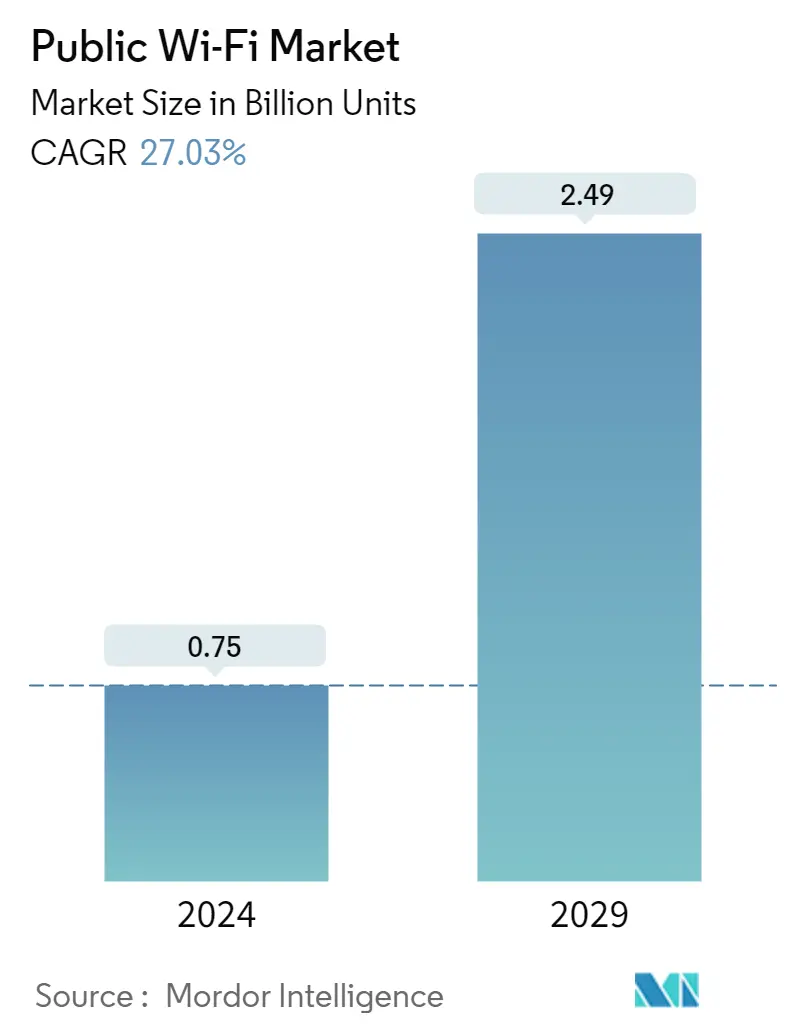Market Size of Public Wi-Fi Industry

| Study Period | 2019 - 2029 |
| Base Year For Estimation | 2023 |
| CAGR (2024 - 2029) | 27.03 % |
| Fastest Growing Market | Asia Pacific |
| Largest Market | Asia Pacific |
| Market Concentration | Medium |
Major Players
*Disclaimer: Major Players sorted in no particular order |
Public Wi-Fi Market Analysis
The Public Wi-Fi Market size is estimated at 0.75 Billion units in 2024, and is expected to reach 2.49 Billion units by 2029, growing at a CAGR of 27.03% during the forecast period (2024-2029).
With the growing push toward 5G technology across the developed economies, mobile subscriptions are expected to see exponential growth. According to the Ericsson's report in 2020, North America's LTE subscriptions stood at 350 million and reduce to 80 million by 2026 as the demand for 5G subscriptions is expected to gain traction. The 5G subscription in the region in 2019 stood at one million and is expected to reach 340 million by 2026.
- As an end user in the mobile-driven world, for heavy bandwidth applications and client dense scenarios outdoors, the market players are ever more reliant on a good Wi-Fi connectivity.
- Players have started offering emerging technology-enabled solutions, which will leverage the market growth of the outdoor Wi-Fi technology. Companies like Grandstream Networks, a communication technology provider, has developed outdoor long-range 802.11ac Wave-2 Wi-Fi access points, which are equipped with the embedded controller and it supports centralized, scalable management system choices like cloud hosted /cloud SaaS or a premise-based Virtual WLAN controller.
- These access points are also equipped with enhanced features, networking standards and protocols like MU-MIMO technology, multiple SSIDs, band steering, dual-2.4GHz/5GHz radio bands, gigabit ethernet ports with PoE/PoE+,802.11ac, mesh networking, 802.11ac Wave 2, captive portal for enterprise branding experiences, client steering, and client bridge function.
- Juniper Networks is launching four new AI-powered, Wi-Fi 6-enabled access points, which will help partners address new application cases being driven by the COVID-19 pandemic. The newly developed solution to Juniper's Wi-Fi portfolio target outdoor applications for businesses, which are now operating remotely, and small businesses, which need to be mindful of costs.
Public Wi-Fi Industry Segmentation
Public Wi-Fi hotspots are created by deploying the necessary wireless hardware that enables internet connection to create a Wi-Fi network that connects devices, such as tablet, smartphone, and computer, among others. These hotspots are deployed across different outdoor locations like railway stations, hotels, airports, cafes, educational institutions, and other public places across regions. Most of the Public-hotspots deployed across regions are due to the government's push to expand internet coverage. Hence, most of the publicly available Wi-Fi hotspots are free. However, they enable different business models.
Public Wi-Fi Market Size Summary
The Public Wi-Fi Market is poised for significant expansion, driven by the increasing demand for robust internet connectivity in both urban and rural areas. As countries like India, China, and Japan advance towards 5G technology, the need for public Wi-Fi access is becoming more critical. This market is characterized by the deployment of free Wi-Fi in major cities and public spaces, offering affordable and scalable internet solutions. The push for digital inclusion is further supported by government initiatives and policies aimed at enhancing broadband penetration. In India, for instance, the National Digital Communication Policy and the PM-Wani initiative are pivotal in establishing millions of public Wi-Fi hotspots, thereby creating a robust digital infrastructure.
The market landscape is moderately fragmented, with key players such as Cisco Systems Inc., EnGenius Technologies, and Socifi Ltd. leading the charge through continuous innovation and strategic acquisitions. Companies are leveraging emerging technologies like AI and Wi-Fi 6 to enhance connectivity solutions, catering to the growing need for high-bandwidth applications. The collaboration between governments, non-profit organizations, and enterprises is also instrumental in bridging the digital divide, as seen in initiatives like Cisco's partnership with Arizona's public libraries. These efforts are complemented by regulatory support, such as the FCC's funding for broadband expansion in rural areas, which collectively foster the growth of the public Wi-Fi market.
Public Wi-Fi Market Size - Table of Contents
-
1. MARKET DYNAMICS
-
1.1 Regional Penetration of Public Wi-Fi
-
1.2 Public Wi-Fi Monetization Models
-
1.3 Stakeholder Analysis
-
1.4 Public Wi-Fi Market Challenges
-
1.5 Key Public Wi-Fi monetization Use-Cases
-
1.6 Regional Analysis
-
1.6.1 North America
-
1.6.2 Europe
-
1.6.3 Asia Pacific
-
1.6.4 Latin America
-
1.6.5 Middle East and Africa
-
-
1.7 Overview of Public Wi-Fi Service Strategy
-
Public Wi-Fi Market Size FAQs
How big is the Public Wi-Fi Market?
The Public Wi-Fi Market size is expected to reach 0.75 billion units in 2024 and grow at a CAGR of 27.03% to reach 2.49 billion units by 2029.
What is the current Public Wi-Fi Market size?
In 2024, the Public Wi-Fi Market size is expected to reach 0.75 billion units.

